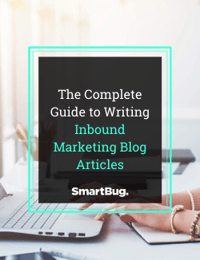
Whether you’re just starting your first blog or are a veteran blogger, there will come a time when you’re staring down writer’s block. It could be because it’s a Friday afternoon and your brain has already started the weekend, or it could be that you can’t figure out what you should write about.
Often, people stick to the same blogging style for every article, forgetting that there are many types of blog articles that can help mix things up. Not only will mixing up your blog content help conquer writer’s block, but it will also keep your readers engaged because your work won’t be so predictable from article to article.
Instead of listing every single type of article imaginable, below is a list of some of the most effective blog article types that are truly beneficial for increasing your visits and leads.
1. Lists
You see these types of blogs articles all over the internet:
- Top 10 How-To YouTube Videos
- 10 Reasons Everybody Is Talking About Game of Thrones
- 5 Holiday Recipes You Have to Try
It’s not a coincidence—there’s a reason for this trend:
- Lists are a great way to streamline information in a digestible and easy-to-share format. When people don’t have time to sit down and read a full blog article, they can easily skim a list-style article and get all of the information they need.
- Lists are great traffic builders and are more likely to go viral than other types of articles.
Bottom line: People like reading lists. Case in point: You’re reading one right now.
2. How-To Guides
Aside from checking social media and email multiple times a day, many people search the internet to discover how to do something. Whether it’s baking a pie or tying a bow tie, people are looking for solutions to their problems. If they see you have the answer they’re looking for, they'll likely click on the link to your site to read the article.
Sharing your industry knowledge and thought leadership in how-to articles shows your personas that you know what you’re talking about, which sets the stage for powerful lead generation. The more you help them, the more they’ll want from you, and the more they’ll download your content.
In addition to sharing your knowledge on the topic in writing, videos are a great way to visually show your audience how something is done.
3. Checklists/Cheat Sheets
Checking an item off the list, knowing you’ve accomplished a task, is very satisfying.
Providing a checklist for your audience gives them a step-by-step breakdown of what they need to do to achieve a goal. Checklists differ from how-to articles in that checklists don’t leave any room for interpretation.
Checklists and cheat sheets can serve as a quick reference guide for your audience when time is limited. Provide this useful resource and your audience will probably want to consume and download more of your valuable content.
4. Infographics
Although infographics aren’t the best tool for lead generation, they are a fantastic resource for driving visits to your site and raising awareness. They’re easy to digest, informative, and entertaining. Plus, infographics deliver a nice break from your average wordy blog article.
Additionally, more often than not, people will place an embed code near the infographic to make it easy for people to embed it on their site, increasing the odds of sharing and more backlinks to your site. If you create an infographic, definitely include the embed code to take advantage of the benefits.
5. Profiles
Profiles articles are perfect for when you want to develop a piece of content that highlights an industry expert, influencer, customer, or anyone relevant to your buyer personas.
Conduct an interview with your chosen subject by scheduling a video, phone, or in-person interview, or send a list of questions that they can provide written responses for.
This type of article has a lot of sharing potential to drive traffic to your site because there’s a good chance that the interviewee will want to share the content with their networks, too.
Bottom line: It shows their expertise and mixes up your blogging style at the same time.
6. Guest Blogging
Guest blogging is beneficial because you can deliver a fresh perspective on your industry, product, service, and more. There are multiple benefits for both you and the guest blogger.
Guest Blogging Benefits for You
- Connects you with a new audience
- Gives a fresh perspective that’s different from your own
- Increases your opportunities for networking
- Keeps your content calendar on track without actually requiring you to create new content
Benefits for the Guest Blogger
- Increases exposure
- Adds to credibility
- Increases the number of inbound links driving to their site (great for SEO)
- Grows social media reach
- Increases networking opportunities
Be sure to give your guest writer blogging guidelines so they have everything they need to keep with the tone of your blog. Remind your guest blogger to avoid self-promotion and focus on education.
7. Newsworthy Articles
Newsworthy articles are intriguing to audiences because of their timeliness. People want to know what the buzz is all about and are more apt to click on your article when they think it’s helping them “be in the know.”
If something important happened within your industry, it’s important to let your buyer personas know about it. If they see that you’re current with all of the latest trends in the industry, they’ll see you as a true expert and an authority in your field where they can go in the future for all of the latest trends and news. The more a person trusts you as an expert, the more likely they’ll buy from you.
8. Personal Stories
Great storytellers can engage people no matter what the topic. The more you can connect with somebody on an emotional level, the more likely they’ll trust you, which could lead to them buying from you.
However, don’t get personal stories confused with self-promotion. Self-promotion is the last thing you want to do in a blog article at the awareness stage. The point of storytelling is to establish a human connection and strike an emotional chord with your audience while staying educational.
Ask yourself this: “What does the reader gain from this content?” If it’s valuable to your audience, publish it. If not, it’s time for a rewrite.
9. Case Studies
Have you ever tried to tell a friend what a great singer (or whatever talent) you are, and they nod politely but don’t think twice about it? But then when you sing for that friend and they hear your amazing voice, they’re blown away and want to hear more? There’s a key difference between somebody telling you something and someone showing that same thing to you, which is where case studies come in.
Case study blog articles are great for lead conversion. Why? They show real-life examples of a topic that is valuable to your niche. Readers will be more apt to believe that you know what you’re talking about when they see actual examples, making them more likely to turn into customers.
10. Data Studies
Sometimes, numbers speak louder than words. Our industry—and most others—utilize data to support decision-making, which means cold, hard facts are more compelling to certain audiences.
Data study blog articles should use visuals to tell the story (even the biggest numbers people don’t want to see as just a list of bullet-pointed statistics). Pie charts, bar charts, line graphs, and scatter plots are great ways to create impactful visuals.
If you’re using a collection of data studies to tell your story, this is a great way to backlink to other companies that could help promote the piece.
Final Thoughts
These blog article ideas are not the be-all, end-all when it comes to writing blog posts. However, they should give you some good options for mixing up structure and content to keep your audience engaged.
Give a few a try to figure out what your readers are interested in. And if you’re ready to dive in a bit deeper on the topic, give The Complete Guide to Writing Inbound Marketing Blog Articles a read.
This blog was originally published in 2016 and has been updated since.
.jpg?width=120&height=120&name=About_Team_IsaacLauritsen_1%20(1).jpg)
About the author
Isaac Lauritsen is a copywriter with SmartBug Media. Read more articles by Isaac Lauritsen.









